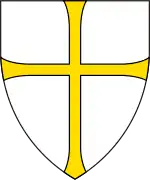Leksvik
Leksvik is a former municipality in the old Nord-Trøndelag county (now in Trøndelag county), Norway. The administrative center of the municipality was the village of Leksvik. Other villages in Leksvik included Vanvikan, Seter, and Dalbygda. Norwegian County Road 755 is the main road that connected the whole municipality from north to south.
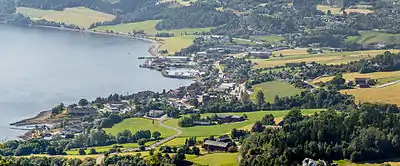
Leksvik kommune | |
|---|---|
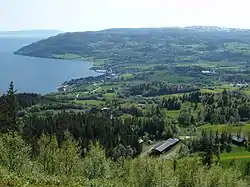 View of the village of Leksvik | |
 Flag 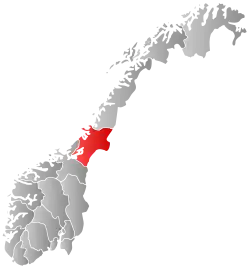 Nord-Trøndelag within Norway | |
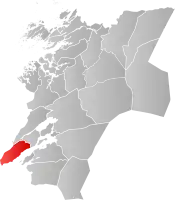 Leksvik within Nord-Trøndelag | |
| Coordinates: 63°39′59″N 10°29′29″E | |
| Country | Norway |
| County | Nord-Trøndelag |
| District | Fosen |
| Established | 1 Jan 1838 |
| • Created as | Formannskapsdistrikt |
| Disestablished | 31 Dec 2017 |
| • Succeeded by | Indre Fosen in 2018 |
| Administrative centre | Leksvik |
| Area (upon dissolution) | |
| • Total | 430.22 km2 (166.11 sq mi) |
| • Land | 399.70 km2 (154.33 sq mi) |
| • Water | 30.52 km2 (11.78 sq mi) |
| • Rank | #230/426 in Norway |
| Population (2017) | |
| • Total | 3,480 |
| • Rank | #249/426 in Norway |
| • Density | 8.7/km2 (23/sq mi) |
| Demonym | leksværing[1] |
| Official language | |
| • Norwegian form | Neutral |
| Time zone | UTC+01:00 (CET) |
| • Summer (DST) | UTC+02:00 (CEST) |
| ISO 3166 code | NO-1718 |
The villages of Leksvik and Vanvikan were the two largest urban areas in Leksvik, notable for their high tech industries which have developed to become advanced and in demand. Areas with agriculture were also widespread, but most of the municipality was covered in forests and mountains where the wildlife ruled with animals such as moose and reindeer. The moose are sometimes seen in the heart of Leksvik and Vanvikan, where modern downtown areas with commercial and residential developments are growing.
The 430-square-kilometre (170 sq mi) municipality was the 220th largest by area out of the then 426 municipalities in Norway at the time of its dissolution. Leksvik was the 249th most populous municipality in Norway with a population of 3,480. The municipality's population density was 8.7 inhabitants per square kilometre (23/sq mi) and its population had decreased by 0.1% over the last decade.[3]
General information
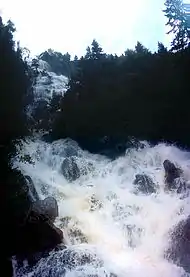
Leksvik was established as a municipality on 1 January 1838 (see formannskapsdistrikt). It was one of very few municipalities in Norway with unchanged borders since that date.[4]
The municipality of Leksvik was merged with the neighboring municipality of Rissa on 1 January 2018. The new municipality was named Indre Fosen and is located in the newly merged Trøndelag county.[5]
Name
The municipality (originally the parish) is named after the old Leksvik farm (Old Norse: Lexuvík) since the first Leksvik Church was built there. The first element is Lexa which is the genitive case of a river name. The name of the river is possibly derived from the word lax which means "salmon".. The last element is vík which means "inlet". Historically, the name has also been spelled Lexvigen or Leksviken.[6]
Coat of arms
The coat of arms was granted on 28 September 1990 and they were in use until 1 January 2018 when the municipality was dissolved (the same arms were re-adopted for the new Indre Fosen Municipality after the merger of Leksvik and Rissa Municipality on that date). The official blazon is "Per chevron embowed azure and argent point ending in trefoil" (Norwegian: I blått en innbøyd sølv spiss som ender i et kløverblad). This means the arms have a field (background) that is divided by a line in the shape of a chevron with curved sides that meet at a point. A trefoil is located on top of this point. The background above the line is blue and the background below this line has a tincture of argent which means it is commonly colored white, but if it is made out of metal, then silver is used. The blue part represents the Trondheimsfjord and the white/silver part represents the land, particularly the Amborneset peninsula where King Sverre Sigurdsson fought his last sea battle on 8 June 1198. There is a clover/trefoil design at the end of the silver part which represents life and growth. The arms were designed by Einar H. Skjærvold.[7][8][9]
Churches
The Church of Norway had one parish (sokn) within the municipality of Leksvik. It was part of the Fosen prosti (deanery) in the Diocese of Nidaros.
| Parish (sokn) | Church name | Location of the church | Year built |
|---|---|---|---|
| Leksvik | Leksvik Church | Leksvik | 1670 |
| Stranda | Stranda Church | Vanvikan | 1897 |
Geography
Leksvik was located on the eastern side of the Fosen peninsula along the coast of Trondheimsfjorden. There are two large lakes located in Leksvik: Storvatnet and Meltingvatnet.
Government
While it existed, this municipality was responsible for primary education (through 10th grade), outpatient health services, senior citizen services, unemployment and other social services, zoning, economic development, and municipal roads. During its existence, this municipality was governed by a municipal council of elected representatives, which in turn elected a mayor.[10]
Municipal council
The municipal council (Kommunestyre) of Leksvik was made up of 25 representatives that were elected to four year terms. The party breakdown of the final municipal council was as follows:
| Party Name (in Norwegian) | Number of representatives | |
|---|---|---|
| Labour Party (Arbeiderpartiet) | 10 | |
| Progress Party (Fremskrittspartiet) | 2 | |
| Conservative Party (Høyre) | 5 | |
| Christian Democratic Party (Kristelig Folkeparti) | 1 | |
| Centre Party (Senterpartiet) | 5 | |
| Socialist Left Party (Sosialistisk Venstreparti) | 1 | |
| Liberal Party (Venstre) | 1 | |
| Total number of members: | 25 | |
| Party Name (in Norwegian) | Number of representatives | |
|---|---|---|
| Labour Party (Arbeiderpartiet) | 7 | |
| Progress Party (Fremskrittspartiet) | 3 | |
| Conservative Party (Høyre) | 5 | |
| Christian Democratic Party (Kristelig Folkeparti) | 2 | |
| Centre Party (Senterpartiet) | 6 | |
| Socialist Left Party (Sosialistisk Venstreparti) | 1 | |
| Liberal Party (Venstre) | 1 | |
| Total number of members: | 25 | |
| Party Name (in Norwegian) | Number of representatives | |
|---|---|---|
| Labour Party (Arbeiderpartiet) | 8 | |
| Progress Party (Fremskrittspartiet) | 4 | |
| Conservative Party (Høyre) | 3 | |
| Christian Democratic Party (Kristelig Folkeparti) | 2 | |
| Centre Party (Senterpartiet) | 6 | |
| Socialist Left Party (Sosialistisk Venstreparti) | 1 | |
| Liberal Party (Venstre) | 1 | |
| Total number of members: | 25 | |
| Party Name (in Norwegian) | Number of representatives | |
|---|---|---|
| Labour Party (Arbeiderpartiet) | 8 | |
| Progress Party (Fremskrittspartiet) | 3 | |
| Conservative Party (Høyre) | 3 | |
| Christian Democratic Party (Kristelig Folkeparti) | 1 | |
| Centre Party (Senterpartiet) | 7 | |
| Socialist Left Party (Sosialistisk Venstreparti) | 2 | |
| Liberal Party (Venstre) | 1 | |
| Total number of members: | 25 | |
| Party Name (in Norwegian) | Number of representatives | |
|---|---|---|
| Labour Party (Arbeiderpartiet) | 8 | |
| Conservative Party (Høyre) | 5 | |
| Christian Democratic Party (Kristelig Folkeparti) | 2 | |
| Centre Party (Senterpartiet) | 8 | |
| Socialist Left Party (Sosialistisk Venstreparti) | 1 | |
| Liberal Party (Venstre) | 1 | |
| Total number of members: | 25 | |
| Party Name (in Norwegian) | Number of representatives | |
|---|---|---|
| Labour Party (Arbeiderpartiet) | 7 | |
| Conservative Party (Høyre) | 3 | |
| Christian Democratic Party (Kristelig Folkeparti) | 2 | |
| Centre Party (Senterpartiet) | 11 | |
| Socialist Left Party (Sosialistisk Venstreparti) | 1 | |
| Liberal Party (Venstre) | 1 | |
| Total number of members: | 25 | |
| Party Name (in Norwegian) | Number of representatives | |
|---|---|---|
| Labour Party (Arbeiderpartiet) | 7 | |
| Conservative Party (Høyre) | 3 | |
| Christian Democratic Party (Kristelig Folkeparti) | 2 | |
| Centre Party (Senterpartiet) | 10 | |
| Socialist Left Party (Sosialistisk Venstreparti) | 1 | |
| Liberal Party (Venstre) | 2 | |
| Total number of members: | 25 | |
| Party Name (in Norwegian) | Number of representatives | |
|---|---|---|
| Labour Party (Arbeiderpartiet) | 10 | |
| Conservative Party (Høyre) | 3 | |
| Christian Democratic Party (Kristelig Folkeparti) | 2 | |
| Centre Party (Senterpartiet) | 8 | |
| Socialist Left Party (Sosialistisk Venstreparti) | 1 | |
| Liberal Party (Venstre) | 1 | |
| Total number of members: | 25 | |
| Party Name (in Norwegian) | Number of representatives | |
|---|---|---|
| Labour Party (Arbeiderpartiet) | 10 | |
| Conservative Party (Høyre) | 3 | |
| Christian Democratic Party (Kristelig Folkeparti) | 2 | |
| Centre Party (Senterpartiet) | 8 | |
| Liberal Party (Venstre) | 2 | |
| Total number of members: | 25 | |
| Party Name (in Norwegian) | Number of representatives | |
|---|---|---|
| Labour Party (Arbeiderpartiet) | 8 | |
| Conservative Party (Høyre) | 3 | |
| Christian Democratic Party (Kristelig Folkeparti) | 3 | |
| Centre Party (Senterpartiet) | 9 | |
| Liberal Party (Venstre) | 2 | |
| Total number of members: | 25 | |
| Party Name (in Norwegian) | Number of representatives | |
|---|---|---|
| Labour Party (Arbeiderpartiet) | 7 | |
| Conservative Party (Høyre) | 1 | |
| Christian Democratic Party (Kristelig Folkeparti) | 3 | |
| Centre Party (Senterpartiet) | 10 | |
| Free Voters List (Frie Velgeres Liste) | 4 | |
| Total number of members: | 25 | |
| Party Name (in Norwegian) | Number of representatives | |
|---|---|---|
| Labour Party (Arbeiderpartiet) | 7 | |
| Conservative Party (Høyre) | 1 | |
| Christian Democratic Party (Kristelig Folkeparti) | 3 | |
| Centre Party (Senterpartiet) | 9 | |
| Liberal Party (Venstre) | 1 | |
| Total number of members: | 21 | |
| Party Name (in Norwegian) | Number of representatives | |
|---|---|---|
| Labour Party (Arbeiderpartiet) | 6 | |
| Conservative Party (Høyre) | 2 | |
| Christian Democratic Party (Kristelig Folkeparti) | 3 | |
| Centre Party (Senterpartiet) | 7 | |
| Local List(s) (Lokale lister) | 3 | |
| Total number of members: | 21 | |
| Party Name (in Norwegian) | Number of representatives | |
|---|---|---|
| Labour Party (Arbeiderpartiet) | 7 | |
| Joint List(s) of Non-Socialist Parties (Borgerlige Felleslister) | 5 | |
| Local List(s) (Lokale lister) | 9 | |
| Total number of members: | 21 | |
| Party Name (in Norwegian) | Number of representatives | |
|---|---|---|
| Labour Party (Arbeiderpartiet) | 5 | |
| Centre Party (Senterpartiet) | 1 | |
| Joint List(s) of Non-Socialist Parties (Borgerlige Felleslister) | 7 | |
| Local List(s) (Lokale lister) | 8 | |
| Total number of members: | 21 | |
| Party Name (in Norwegian) | Number of representatives | |
|---|---|---|
| Labour Party (Arbeiderpartiet) | 4 | |
| Joint List(s) of Non-Socialist Parties (Borgerlige Felleslister) | 13 | |
| Local List(s) (Lokale lister) | 4 | |
| Total number of members: | 21 | |
| Party Name (in Norwegian) | Number of representatives | |
|---|---|---|
| Labour Party (Arbeiderpartiet) | 5 | |
| Local List(s) (Lokale lister) | 15 | |
| Total number of members: | 20 | |
| Party Name (in Norwegian) | Number of representatives | |
|---|---|---|
| Labour Party (Arbeiderpartiet) | 3 | |
| Local List(s) (Lokale lister) | 17 | |
| Total number of members: | 20 | |
| Party Name (in Norwegian) | Number of representatives | |
|---|---|---|
| Labour Party (Arbeiderpartiet) | 3 | |
| List of workers, fishermen, and small farmholders (Arbeidere, fiskere, småbrukere liste) | 1 | |
| Local List(s) (Lokale lister) | 16 | |
| Total number of members: | 20 | |
| Party Name (in Norwegian) | Number of representatives | |
|---|---|---|
| Labour Party (Arbeiderpartiet) | 3 | |
| Joint List(s) of Non-Socialist Parties (Borgerlige Felleslister) | 5 | |
| Local List(s) (Lokale lister) | 12 | |
| Total number of members: | 20 | |
| Note: Due to the German occupation of Norway during World War II, no elections were held for new municipal councils until after the war ended in 1945. | ||
Mayors
The mayors of Leksvik:[28]
- 1838–1840: Johan Albricht Carl Dons
- 1840–1841: Nils Hjellup
- 1842–1845: Christopher Winther Scheen
- 1845-1846: Ole H. Krabseth
- 1846–1849: Petter A. Grande
- 1850–1857: Ole J. Moholdt
- 1858–1859: Ole Aalberg
- 1860–1863: Hans Bull Motzfeldt
- 1864–1865: Ole J. Moholdt
- 1866–1869: Ole Aalberg
- 1870–1871: Aage Casper Larsen Winge
- 1872–1883: Hans Bull Motzfeldt (H)
- 1884–1888: Carl Ludvig Møller (H)
- 1888–1893: Ole Moxnes (V)
- 1894–1895: Hans Strand (H)
- 1896–1897: Ole Moxnes (V)
- 1898–1916: Hans Strand (H)
- 1917–1922: Karl Myran (Av)
- 1923–1925: Arnt Bye
- 1926–1937: Edvard Grande (V)
- 1938–1941: P.A. Rosvold (H)
- 1941–1945: Hartvig Dalsaune
- 1945–1947: P.A. Rosvold (H)
- 1948–1949: Ole Graven (V)
- 1950–1951: Ole Hindrum (Bp)
- 1952–1960: Elias Grande (V)
- 1961–1963: Johan Hindrum (Sp)
- 1964–1967: Hans Kirkhus (V)
- 1968–1979: Ingvar Sæther (Sp)
- 1980–1983: Olav Moholdt (KrF)
- 1984–1985: Ingvar Sæther (Sp)
- 1986–1995: Ingebjørg Karmhus (Sp)
- 1995–2003: Einar Strøm (Sp)
- 2003–2007: Borghild Husdal Buhaug (Sp)
- 2007–2015: Einar Strøm (Sp)
- 2015–2017: Steinar Saghaug (H)
History
The first inhabitants are believed to have moved to Leksvik some 3,000 years ago. They left several pieces of cutting tools which are now placed in museums. But Leksvik does not appear in recorded history before the Viking Age when the villages Leksvik and Hindrem became quite important in the local area. In both Leksvik and Hindrem there have been found great tombs and ruins of buildings and longboats. On Borgen, there is a hill between Hindrem and Seter that may have been a great Viking fortress, but this could also be tracks made by the glaciers during the last ice age. After the Black Death struck Norway in 1349, Leksvik fell into silence for some 300 years.
In more modern history, Leksvik and Hindrem are small and relatively isolated villages, north of Trondheim Fjord. Two churches stood here, a church in Leksvik and a stave church in Hindrem, but this broke down in 1655 and was replaced by a modern wooden church. In the 19th century, the church of Hindrem was demolished, and the new Stranda Church was built in Vanvikan. Leksvik became well known for its goats and had 5,000 of them at their peak number.
During World War II, Leksvik was settled by German troops with the main camp on the top of Våttåhaugen, a hill north of the village of Leksvik. But as a small and isolated village, nothing of great importance happened there during the war, and it was mostly peaceful although bombs fell over Trondheim, on the south side of the fjord. After electric power first came to Leksvik, Bjørn Lyng founded the first industry in Vanvikan and Leksvik. After the first road was finally finished in the early 1960s, industry grew rapidly and replaced the goats.
Notable people
References
- "Navn på steder og personer: Innbyggjarnamn" (in Norwegian). Språkrådet.
- "Forskrift om målvedtak i kommunar og fylkeskommunar" (in Norwegian). Lovdata.no.
- Statistisk sentralbyrå (2017). "Table: 06913: Population 1 January and population changes during the calendar year (M)" (in Norwegian). Retrieved 2017-10-01.
- Jukvam, Dag (1999). "Historisk oversikt over endringer i kommune- og fylkesinndelingen" (PDF) (in Norwegian). Statistisk sentralbyrå.
- "Om Indre Fosen" (in Norwegian). Indre Fosen kommune. Retrieved 2017-10-01.
- Rygh, Oluf (1903). Norske gaardnavne: Nordre Trondhjems amt (in Norwegian) (15 ed.). Kristiania, Norge: W. C. Fabritius & sønners bogtrikkeri. p. 48.
- "Civic heraldry of Norway - Norske Kommunevåpen". Heraldry of the World. Retrieved 2023-02-12.
- "Leksvik, Nord-Trøndelag (Norway)". Flags of the World. Retrieved 2023-02-12.
- "Godkjenning av våpen og flagg". Lovdata.no (in Norwegian). Norges kommunal- og arbeidsdepartementet. 1990-12-09. Retrieved 2023-02-12.
- Hansen, Tore; Vabo, Signy Irene, eds. (2022-09-20). "kommunestyre". Store norske leksikon (in Norwegian). Kunnskapsforlaget. Retrieved 2023-01-01.
- "Table: 04813: Members of the local councils, by party/electoral list at the Municipal Council election (M)" (in Norwegian). Statistics Norway.
- "Tall for Norge: Kommunestyrevalg 2011 - Nord-Trøndelag". Valg Direktoratet. Retrieved 2020-04-19.
- "Kommunestyrevalget 1995" (PDF) (in Norwegian). Oslo-Kongsvinger: Statistisk sentralbyrå. 1996. Retrieved 2020-04-14.
- "Kommunestyrevalget 1991" (PDF) (in Norwegian). Oslo-Kongsvinger: Statistisk sentralbyrå. 1993. Retrieved 2020-04-14.
- "Kommunestyrevalget 1987" (PDF) (in Norwegian). Oslo-Kongsvinger: Statistisk sentralbyrå. 1988. Retrieved 2020-04-14.
- "Kommunestyrevalget 1983" (PDF) (in Norwegian). Oslo-Kongsvinger: Statistisk sentralbyrå. 1984. Retrieved 2020-04-14.
- "Kommunestyrevalget 1979" (PDF) (in Norwegian). Oslo: Statistisk sentralbyrå. 1979. Retrieved 2020-04-14.
- "Kommunevalgene 1975" (PDF) (in Norwegian). Oslo: Statistisk sentralbyrå. 1977. Retrieved 2020-04-14.
- "Kommunevalgene 1972" (PDF) (in Norwegian). Oslo: Statistisk sentralbyrå. 1973. Retrieved 2020-04-14.
- "Kommunevalgene 1967" (PDF) (in Norwegian). Oslo: Statistisk sentralbyrå. 1967. Retrieved 2020-04-14.
- "Kommunevalgene 1963" (PDF) (in Norwegian). Oslo: Statistisk sentralbyrå. 1964. Retrieved 2020-04-14.
- "Kommunevalgene og Ordførervalgene 1959" (PDF) (in Norwegian). Oslo: Statistisk sentralbyrå. 1960. Retrieved 2020-04-14.
- "Kommunevalgene og Ordførervalgene 1955" (PDF) (in Norwegian). Oslo: Statistisk sentralbyrå. 1957. Retrieved 2020-04-14.
- "Kommunevalgene og Ordførervalgene 1951" (PDF) (in Norwegian). Oslo: Statistisk sentralbyrå. 1952. Retrieved 2020-04-14.
- "Kommunevalgene og Ordførervalgene 1947" (PDF) (in Norwegian). Oslo: Statistisk sentralbyrå. 1948. Retrieved 2020-04-14.
- "Kommunevalgene og Ordførervalgene 1945" (PDF) (in Norwegian). Oslo: Statistisk sentralbyrå. 1947. Retrieved 2020-04-14.
- "Kommunevalgene og Ordførervalgene 1937" (PDF) (in Norwegian). Oslo: Statistisk sentralbyrå. 1938. Retrieved 2020-04-14.
- Sæther, Stein Arne, ed. (1993). Fosen. Natur, kultur og mennesker (in Norwegian). Trondheim: Adresseavisens Forlag. pp. 215–216.
External links
 Trøndelag travel guide from Wikivoyage
Trøndelag travel guide from Wikivoyage- Webcam showing the view from Leksvik in the direction of Frosta
- European ash north to Leksvik


